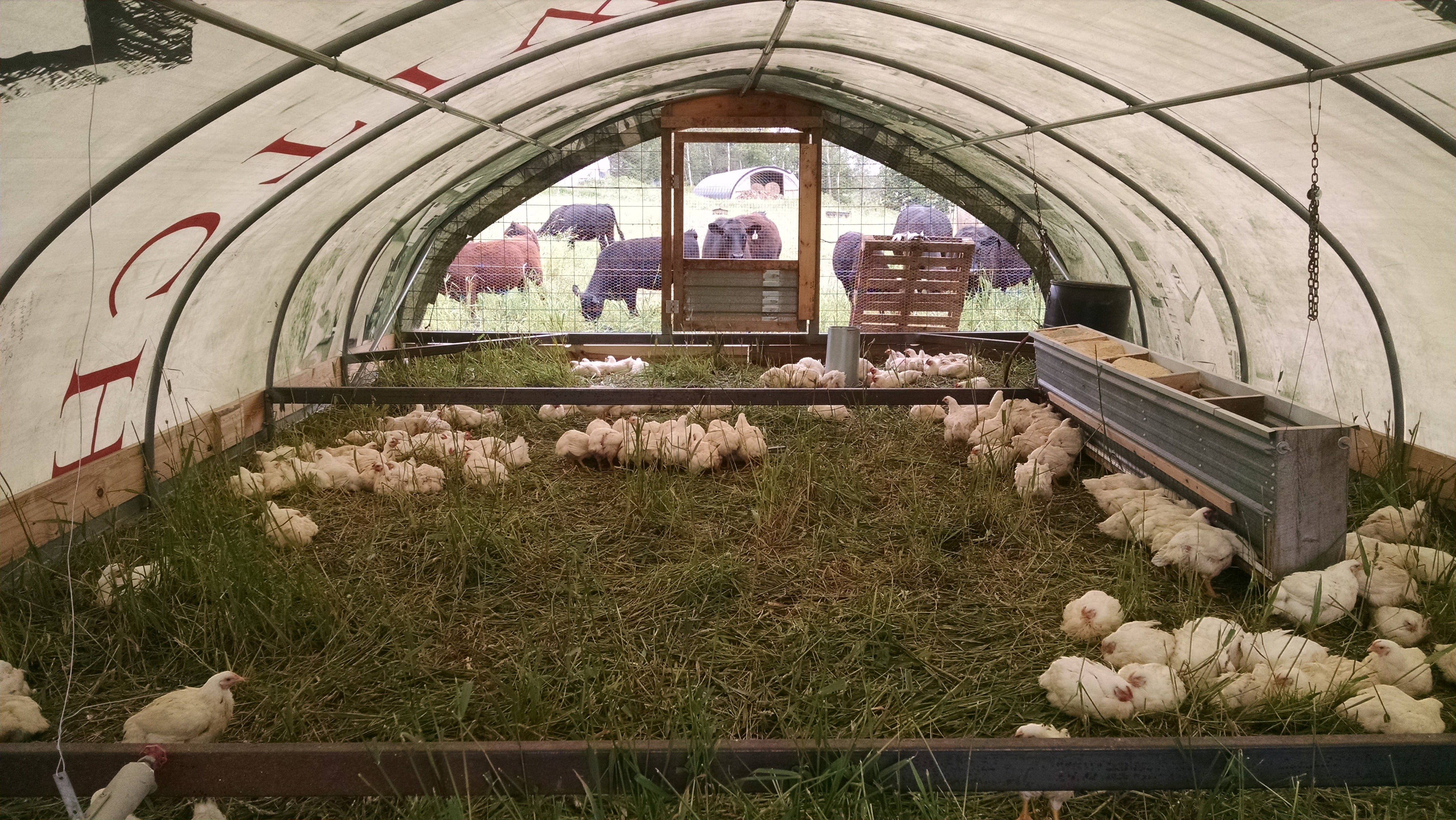2021 Update: This article shows our first phase of developing larger pasture coops for our chickens. We still use this shelter, but we’ve continued to refine the design. For a look at the newer, more refined shelters check out this blog post.
We, like most pasture farmers, got our start with meat chickens using Joel Salatin-inspired field pens. There are numerous variations on that design, but having seen and used many alternatives, I think Joel’s 10×12 pens are about the most efficient tradeoff in terms of weight, cost, and wind resistance. The low initial investment makes it easy for someone to get into pasture raised chicken. Their modular nature makes it easy to add another coop (or another dozen coops).
While those smaller shelters work well in Joel’s farm, they never worked well for us. Context is ever-important in farming. Here are a few reasons:
- Labor is a bigger issue on our farm than his. Modular solutions like the Salatin coop have a big downfall: there is no way to streamline the work in feeding, watering, and moving each small coop, so every time you grow your chicken flock, you linearly increase your effort.
- The market conditions for pastured chicken have changed compared to when Joel did his pioneering work and built his reputation, as industrial organic factory farm chicken producers co-opted a large portion of the market share, resulting in mass-market “organic, free range” chicken masquerading as something comparable to what we raise on pasture.
- Joel’s sales were built around weekly sales of fresh chicken, whereas our sales are entirely a frozen meat trade so larger batches make more sense for us.
This year several of our five year old chicken coops needed repair or overhaul. Even though the structures are relatively inexpensive, it takes time and a few hundred bucks to build each one. I was inspired to change things after reading Jim Protiva’s article in Graze on his Labor Saving Devices.
I found twenty foot wide greenhouse hoops on Craigslist. I bought new forty foot long 4x4x3/8 galvanized angle irons for the runners, then I cut and welded both ends up like ski tips. I also bought steel 2x4x3/16 tubes for the crossties to prevent the hoops from splaying. All the weight of the steel might have been overkill, but I want a coop that stays put when the wind blows. The cover is a recycled billboard tarp (an advertisement for Salem Witch War). We built a ten foot long feeder out of rain gutters and used siding. It holds 400 pounds of feed so we don’t spend nearly as much time filling up feeders. Water is supplied by a tote on a little trailer we tow alongside, but we also installed a supplemental 55 gallon water tank in the coop in case we need the trailer elsewhere.
This year we changed our feed mill, so it is hard to know what to attribute to feed versus housing, but we have not lost a single chicken on pasture this year (they will be 7-1/2 weeks old). The conditions inside the hoophouse are far more pleasant than the stuffy air in the Salatin coops. The white billboard allows light in, but blocks the heat. The screened end panels allow air to circulate so there’s always a breeze. I like that I can walk among the chickens to check on them, rather than trying to peer down into the dark corners of low-slung coops. Better conditions for us make for better conditions for the chickens since we tend to pay closer attention when conditions aren’t so unpleasant.
The hoophouse tows tolerably with a pickup truck in four wheel drive unless the grass is wet. The four wheeler is too light to move it, but our tractor does the job easily. I’m sure any subcompact tractor in the 25-plus horsepower range would work as long as the tires have grip. When we tow the hoophouse, AJ usually herds the chickens away from the back wall while I slowly move it forward. If a bird happens to get past him, we didn’t want the problem of them getting smeared by the back wall, so we built the lower edge of the front and back walls out of 2×10 lumber hinged from the steel crossties. This hinged connection also allows the chicken coop to contain the chickens when parked on uneven ground.
We have 200 pasture raised chickens in this house. I think we could easily go up to 450 with plenty of legroom for everyone.


2 thoughts on “Building a Better Pasture Chicken Coop”
Hi Dave,
Is this type of chicken coop still working out for you?
I’m planning out my first coop, which will be moving along our relatively flat pasture, but has somewhat rough, uneven terrain. I’m particularly concerned about openings along the bottom of the coop allowing in predators.
Thanks for any input!
Yes, we’re still using them. Here’s a more detailed description of the the construction:
Important Design Features In Our Shelters for Pasture Raised Chickens
Gaps can be a problem. Sometimes we find it necessary to stuff hay into ruts or gaps in our rougher areas.